Disclaimer
Information provided on this website is general in nature and does not constitute financial advice. Every effort has been made to ensure that the information provided is accurate. Individuals must not rely on this information to make a financial or investment decision. Before making any decision, we recommend you consult a financial adviser to take into account your particular investment objectives, financial situation and individual needs.
Weekly Market Update – 30th September 2022

Investment markets & key developments
- Share markets fell sharply again over the last week in response to continuing hawkish central bank comments and rising recession fears not helped by a mini fiscal crisis in the UK. This capped of sharp falls for the month with US and global shares down around 8%, which saw September live up to its reputation as the weakest month of the year for shares. Reflecting the poor global lead Australian shares also fell around 1.5% for the week with falls led by property, utility, financial and energy stocks. For the month Australian shares fell about 7.5%. Bond yields rose further not helped by the UK crisis. Oil and metal prices rose slightly but iron ore prices fell. The $A fell below $US0.65, despite a slight fall in the $US.
- Despite a brief mid-week bounce shares remain oversold and could still have a more sustained bounce from these levels. But beyond that they remain at high risk of more downside in the short term as central banks remain hawkish, recession risks are high and rising, the conflict in Ukraine looks likely to escalate with Russia moving to annex occupied territory, we remain in a seasonally weak period of the year for shares out to mid-October and earnings expectations are still being revised down. While investor confidence is very negative, we are still yet to see the sort of spike in put/call ratios or Vix that signals major market bottoms. A decisive break below the June low for the US share market could open up another 5-10% leg down with a similar flow through to Australian shares.
- Mayhem in the UK. The financial market turmoil in the UK – which saw a surge in bond yields and a plunge in the pound which was triggered by the UK Government’s fiscal stimulus – would normally have been a bit of a sideshow. But it impacted global markets because it engendered a sense of crisis. The Bank of England’s intervention to calm the gilt market (which was threatening financial problems for UK pension funds) by buying bonds (ie restarting QE) has helped calm things – directly in the UK and indirectly elsewhere by showing that authorities will still intervene in a crisis. This in turn saw bond yields fall back a notch in the US and Europe. Unfortunately, the return to QE may just add to inflationary pressures if it has to be sustained for long, which may necessitate an even higher interest rate hike when the BoE next meets in early November with many talking about a 1.25% hike, which leaves the BoE in the silly position of easing and tightening at the same time.
- The broader issue though remains the aggressive monetary tightening we are now seeing globally. Concerns remain that the Fed and other central banks have become locked into supersized hikes based on backward looking inflation and jobs data at a time when they should be giving more attention to monetary policy lags. This increases the risk of overtightening driving a deep recession.
- Consistent with the threat to growth and risk of recession we are seeing further downgrades to the growth outlook. This was highlighted by the OECD downgrading its 2023 global growth forecast to 2.2% with Germany negative, the UK flat, the Eurozone at 0.3% and the US at 0.5%. Australia was cut to around 2%. Consistent with this, earnings expectations are being revised down.

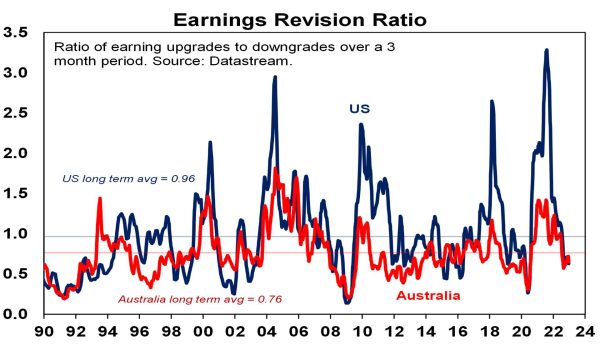
- However, there remain snippets of good news and reason for optimism on a 12 month horizon. The Pipeline Inflation Indicator continues to slow, US rents are now falling as is the US money supply all of which suggest that inflation will fall faster than the Fed is now expecting and inflation expectations outside of Europe have fallen.

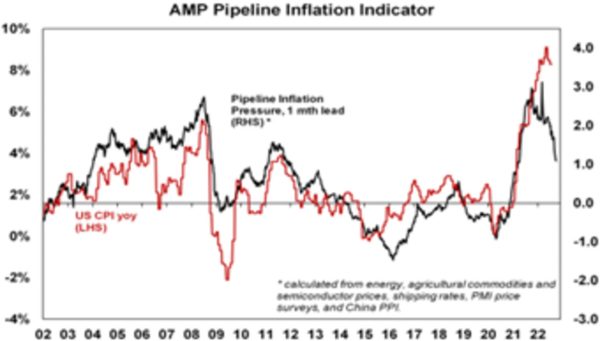
- The bottom line is that while short term inflation remains high, these considerations are consistent with the US having reached peak inflation and point to sharply lower inflation ahead which should enable central banks to slow down the pace of hiking by year end hopefully in time to avoid a severe recession (except perhaps in Europe). If this applies in the US, then Australia should follow as its lagging the US by about six months with respect to inflation. For this reason, while shares are likely to fall further in the short term, remain optimistic on shares on a 12-month horizon.
- In Australia, the RBA is expected to hike rates again on Tuesday. After four back-to-back rate outsized rate hikes the RBA should scale back to a 0.25% hike to be able to better assess their lagged impact and it is expected that it will, but the risk is skewed towards another 0.5% move so it’s a close call. Inflation is still high and rising, jobs data remains strong and economic data releases (outside of housing) remain solid and the RBA has continued to indicate that it expects to raise rates further all of which is consistent with another hike on Tuesday. However, the case to slow down the hikes is very strong:
-
- Monetary policy always operates with a lag as it takes time for rate hikes to flow through to actual mortgage payments and impact spending and after five rate hikes in a row it makes sense to slow down to be able to better assess how they are impacting and allow for the lags to play out.
- Next year a big chunk of homeowners on 2% fixed rates will roll onto rates of around 6% or so, which will result in a massive hit to spending power not currently being felt.
- The plunge in share markets, falling commodity prices, the deteriorating global outlook, low confidence readings and rapidly weakening housing indicators warn of much weaker conditions ahead and the rising risk of recession. This will drive a weaker jobs market and lower inflation.
- The combination of Australian households being far more vulnerable and hence responsive to rising rates than US households (due to higher debt levels and greater exposure to short term interest rate moves) and lower inflation pressures in Australia mean that the RBA does not need to raise rates as aggressively as the Fed.
- While some fret about the falling value of the $A against the $US, its actually been strong on a trade weighted basis suggesting little threat to inflation from the currency.
- The RBA has indicated an awareness of the lags with which rate hikes impact the economy, a desire to keep the economy on an even keel, the need to take account of the risks to growth and employment and an openness to slowing the pace of rate hikes. As such it is likely that it will ease back the pace of hikes to 0.25% while continuing to flag its determination to bring inflation back to target with more rate hikes still expected. However, it’s a very close call as the RBA’s focus on backward looking inflation and jobs data along with the hawkish global central bank consensus risks seeing it stick to 0.5% hikes for now. A 0.4% move might be a good compromise and it is what is factored into money markets.
- A 0.25% rise in the cash rate, if passed on to mortgage holders as is expected, will add roughly another $80 to the monthly payment on a typical $500,000 mortgage which will take the total increase in monthly payments since April to $735 a month or $8820 a year. A 0.5% hike will add $160 a month taking the total increase since April to $815 a month or $9780 a year. This will likely hit spending in the months ahead.
- Taking the cash rate to 4.15% next year as the money market assumes would knock home prices down 30% & put the economy into a recession we don’t have to have.
- The ABS Monthly CPI Indicator showed a further rise in Australian inflation – but less so than expected. The new monthly inflation indicator rose from 6.8%yoy in June to 7%yoy in July before falling back to 6.8%yoy in August. The fall back in August largely reflected lower fuel prices. Caution should be applied in interpreting the monthly CPI as: it only updates around two thirds of CPI items; it’s very volatile month to month; and there is no trimmed mean or median. Some guide to the underlying trend was provided by a monthly measure excluding fruit, vegetables and fuel and it rose from 5.5%yoy in June to 6.2%yoy in August. Against this though, rolling 3-month momentum in the monthly CPI has slowed from 2.3% in May to 1.7% in June suggesting that price pressures in the items included may have peaked. That said this may be dramatically understating the September quarter CPI because the monthly measure excludes electricity and gas. So for now the September quarter CPI forecast is staying at 1.8%qoq or 7.2%yoy and doubt that the monthly indicator will have much impact on the October RBA decision in line with comments already made by Governor Lowe and Deputy Governor Bullock.

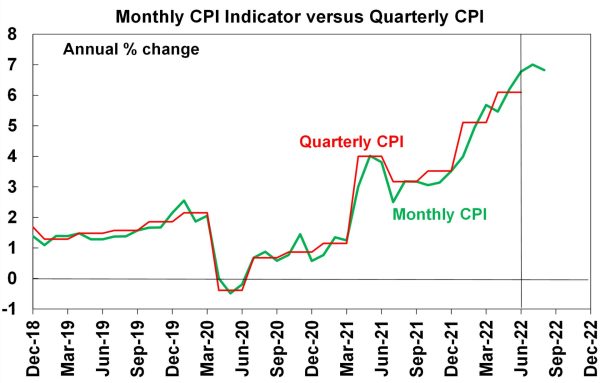
- Australian petrol prices had already moved up ahead of the reversal of the fuel excise cut. While there may still be some impact given lags its likely to be relatively minor as prices had already moved up and prices are averaging around where they should be based on the current level of world oil prices and the Australian dollar, ie around $1.85/litre.

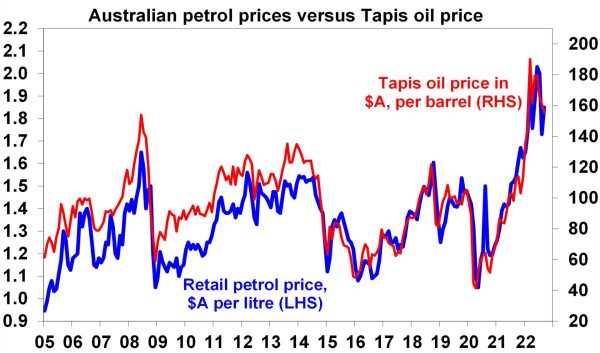
Coronavirus update
- New global covid cases and deaths are still trending down. This includes in Australia. Europe is seeing a bit of a bounce.

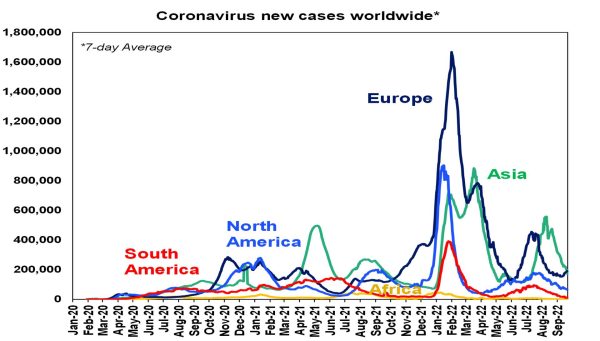
Economic activity trackers
- Our Australian and US European Economic Activity Trackers rose slightly in the last week, but the European Tracker fell. While some momentum has been lost after the recovery from the pandemic, economic activity is holding up reasonably well so far – but this likely reflects the usual lags from monetary tightening.

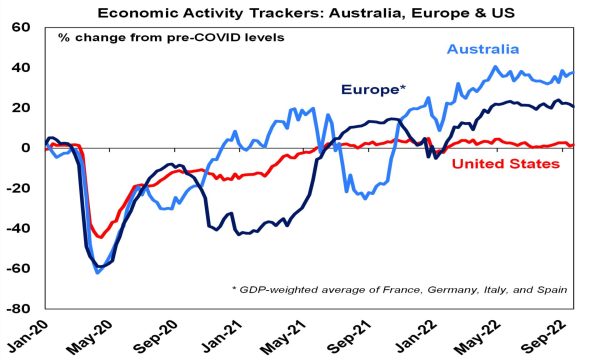
Major global economic events and implications
- US data was mixed. Underlying capital goods orders continue to rise, consumer confidence bounced, jobless claims fell and new home sales rose sharply in August (although this looks like an aberration). Against this pending home sales fell and home prices are falling. A glut of new homes and mortgage rates at levels not seen in decades points to further falls in home prices.
- Eurozone economic confidence slid again in September. Meanwhile ongoing high inflation readings (with German inflation at 10%yoy in September) will likely keep the ECB hawkish. A German plan to subsidize gas and electricity costs (financed by a mix of borrowing and a super profits tax on energy suppliers) will provide some offset though and may help minimise the extent of its coming recession.
- Japan’s composite business conditions PMI rose in September and data for jobs, industrial production and retail sales all improved more than expected.
- Chinese business conditions PMIs generally slowed in September suggesting growth may be faltering again after the mid-year reopening bounce. More stimulus is likely.
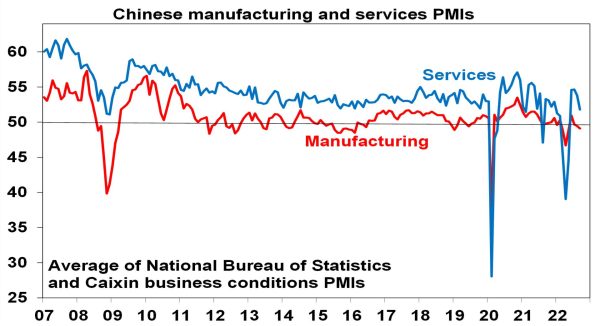

Australian economic events and implications
- In Australia, apart from the monthly CPI covered above, economic data was mixed. Retail sales surprised again on the upside, but a slowdown is coming. While retail sales have remained stronger for longer than expected, continue to expect a slowdown ahead as rate hikes are fully reflected in mortgage payments, rates continue to rise, negative wealth effects from now falling home prices start to impact, consumer confidence remains depressed and the run down in the saving rate runs its course.

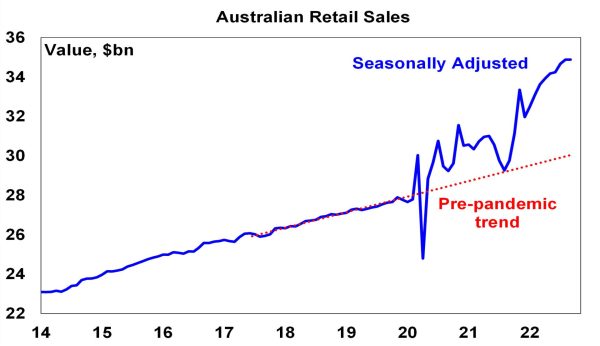
- Job vacancies fell 2.1% over the three months to August, but are still very strong. The number of job vacancies per unemployed worker fell slightly but remains around 1 to 1. The jobs market may be starting to slow but right now it’s still very tight. Of course, it’s one of the last indicators to slow in response to rising rates.

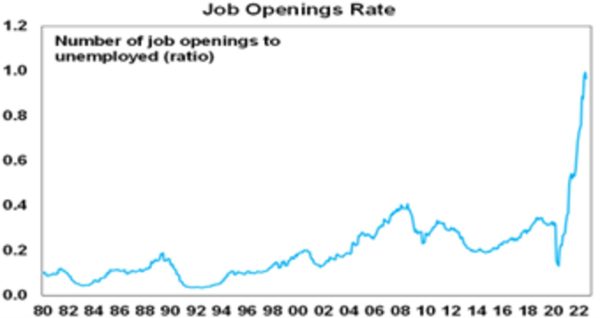
- There was a slight bounce in housing credit growth, particularly for owner occupiers in August but the trend is likely to remain down as the housing downturn weighs.

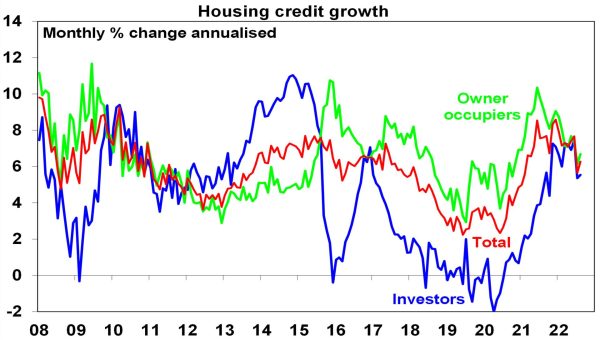
- Australian household wealth fell 3.3% in the June quarter (or by $484bn) after 8 quarters of strong growth as shares & bonds fell (hitting super) and property prices fell. With a lag this will start to act as a drag on consumer spending.
- Australian Federal budget deficit $48bn better than expected for 2021-22 – setting up a somewhat better profile ahead. This saw the final deficit come in at $32bn (1.4% of GDP), down from $80bn projected in March and $99bn in December. Normally this would flow through to sharply lower deficit projections for subsequent years but the flow through this time will likely be limited as: the Government will continue to assume that commodity prices will fall back to much lower levels; unemployment will rise as the economy slows; some of the delayed 2021-22 spending will be pushed into this year; structural pressures from health, aged care, the NDIS, defence and debt interest costs will boost spending in future years; and a likely lower long term productivity growth assumption will lead to lower long term revenue assumptions. So, the Treasurer has indicated that the October Budget will not forecast a surplus across the forward and out years. But the better starting point is still likely to result in some downwards revisions to deficit projections which now look too high. And the Government’s conservative commodity price assumptions mean ongoing scope for upside revenue surprises. As such and barring a severe recession a return to surplus may be conceivable in the second half of the decade.

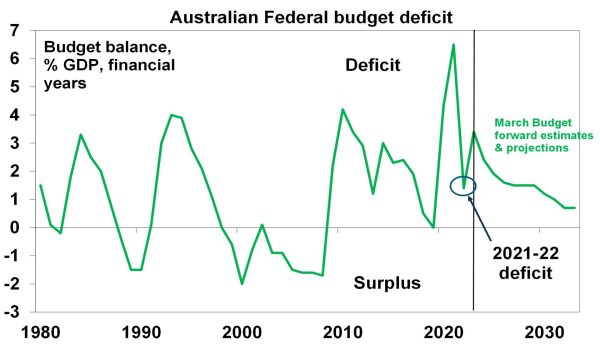
What to watch over the next week?
- In the US, expect September jobs data (Friday) to show a further slowing in payroll growth to 250,000, unemployment unchanged at 3.7% and wages growth slowing to around 5.1%yoy. The ISM manufacturing conditions index (Monday) is expected to fall to 52.4 and the services conditions index (Wednesday) is expected to fall to 56.5, but the risk for both is on the downside. Job opening and hiring data for August (Tuesday) will be watched for signs of cooling.
- Japan’s September quarter Tankan business survey (Monday) is expected to be little changed.
- The Reserve Bank of New Zealand (Wednesday) is expected to raise rates by 0.5% taking the cash rate to 3.5%.
- In Australia, as noted earlier the RBA is expected to hike rates again on Tuesday and expect a scaling back to a 0.25% hike, but recognise that the risks are skewed towards another 0.5% hike. The RBA’s six-monthly Financial Stability Review (Friday) will be watched for further clues as to how the RBA is seeing higher rates impacting households and the economy.
- On the data front in Australia, expect Core Logic home price data for September (Monday) to show a further 1.4% decline, August housing approvals to bounce 8% after a 17% fall in July and housing finance to fall 1% (all due Tuesday), and the trade surplus to fall to around $7bn. The MI Inflation Gauge for September comes out Monday.
Outlook for investment markets
- Shares remain at high risk of further falls in the months ahead as central banks continue to tighten, uncertainty about recession remains high and geopolitical risks continue. However, expect to see shares providing reasonable returns on a 12-month horizon as valuations have improved, global growth ultimately picks up again and inflationary pressures ease through next year allowing central banks to ease up on the monetary policy brakes.
- With bond yields likely at or close to peaking for now, short-term bond returns should improve.
- Unlisted commercial property may see some weakness in retail and office returns (as online retail activity remains well above pre-covid levels and office occupancy remains well below) and the lagged flow through of higher bond yields is likely to drag down unlisted property and infrastructure returns.
- Australian home prices are expected to fall 15 to 20% top to bottom into the second half of next year as poor affordability & rising mortgage rates impact. This assumes the cash rate tops out below 3% but if it rises above 4% as the money market is assuming then home prices will likely fall 30%.
- Cash and bank deposit returns remain low but are improving as RBA cash rate increases flow through.
- The $A is likely to remain at risk of further falls in the short term as global uncertainties persist and as the RBA remains a bit less hawkish than the Fed. However, a rising trend in the $A is likely over the medium term as commodity prices ultimately remain in a super cycle bull market.
Source: AMP CAPITAL ‘Weekly Market Update’
AMP Capital Investors Limited and AMP Capital Funds Management Limited Disclaimer
